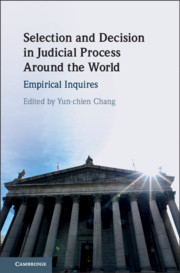Book contents
- Selection and Decision in Judicial Process around the World
- Selection and Decision in Judicial Process around the World
- Copyright page
- Dedication
- Contents
- List of Figures
- List of Tables
- List of Contributors
- Acknowledgments
- Introduction
- 1 Do Patent Law Suits Target Invalid Patents?
- 2 Platform Procedure
- 3 Speedy Adjudication in Hard Cases and Low Settlement Rates in Easy Cases
- 4 How Lower Courts Respond to a Change in a Legal Rule
- 5 Career Judge System and Court Decision Biases
- 6 Judges Avoid Ex Post but Not Ex Ante Inefficiency
- 7 When Winning Is Not Enough
- 8 The Evolution of Case Influence in Modern Consumer Standard Form Contracts
- 9 Judging Insurance Antidiscrimination Law
- 10 Are Judges Harsher with Repeat Offenders?
- 11 Does Efficiency Trump Legality?
- Index
- References
2 - Platform Procedure
Using Technology to Facilitate (Efficient) Civil Settlement
Published online by Cambridge University Press: 04 December 2019
- Selection and Decision in Judicial Process around the World
- Selection and Decision in Judicial Process around the World
- Copyright page
- Dedication
- Contents
- List of Figures
- List of Tables
- List of Contributors
- Acknowledgments
- Introduction
- 1 Do Patent Law Suits Target Invalid Patents?
- 2 Platform Procedure
- 3 Speedy Adjudication in Hard Cases and Low Settlement Rates in Easy Cases
- 4 How Lower Courts Respond to a Change in a Legal Rule
- 5 Career Judge System and Court Decision Biases
- 6 Judges Avoid Ex Post but Not Ex Ante Inefficiency
- 7 When Winning Is Not Enough
- 8 The Evolution of Case Influence in Modern Consumer Standard Form Contracts
- 9 Judging Insurance Antidiscrimination Law
- 10 Are Judges Harsher with Repeat Offenders?
- 11 Does Efficiency Trump Legality?
- Index
- References
Summary
In this chapter, we explore the ability of courts to enhance the role of substantive law in case outcomes by reducing party litigation costs. When it becomes less costly for parties to engage actively in dispute resolution, the shadow of substantive law should, in theory, become more pronounced and case outcomes should change (and hopefully become more accurate/efficient on average). To empirically investigate this hypothesis, we examine the consequences of a large state court’s implementation of court-assisted online dispute resolution (ODR) tools for its small claims docket. A central goal of this technology is to reduce litigation costs of all sorts so that parties are able to communicate easily and negotiate settlements quickly in the shadow of what is —or could be—efficient substantive law, thereby avoiding inefficient status quo outcomes, like default judgments. ODR tools enhance court efficiency and litigant satisfaction by giving parties on‐demand, inexpensive access to a private and secure platform to negotiate an agreement that fully resolves their dispute. We find that, by reducing costs, eliminating procedural inefficiencies, and placing decision-making power in the hands of the parties, platform technology reduces the likelihood of default and likely improves the substantive outcome of disputes.
Keywords
- Type
- Chapter
- Information
- Selection and Decision in Judicial Process around the WorldEmpirical Inquires, pp. 30 - 72Publisher: Cambridge University PressPrint publication year: 2019
References
- 3
- Cited by



